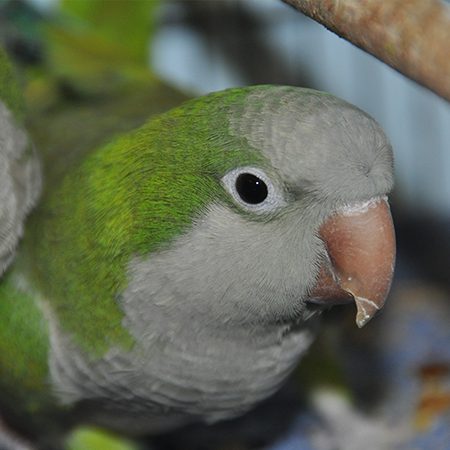Quaker Parrot
Myiopsitta monachus
Quakers are also known as Monk Parakeets, and are found mainly near large water sources in the lower parts of South America. Populations have also formed in cities of North America because of escaped pets. These birds are about a foot long and are generally green or gray in color. Their cheeks tend to be a lighter gray color while their wings are a darker green. They only weigh about 3 ounces. Males and females are not distinct in any obvious way. They will live about 20 years on average.
These birds will live in large flocks together and will migrate if there is not a reliable food source available to them. They will nest in pairs; these nests will be built by weaving sticks, twigs, or any materials they can find. Different compartments will be built to house eggs, older juveniles, and even a room for parents to use for protection. Their outgoing nature to humans has made them popular pets, and are now being bred to have new colorations. They can be found in blue, yellow, cinnamon, pied, and even albino. Unfortunately, they have escaped as pets and become a pest species because they can damage agriculture fields.

Quaker parrots originated in South America ranging across Argentina and Chile.
HABITAT -They live on open savannahs but can adapt readily to other environments.
DIET -They are mainly herbivorous, eating fruits, seeds, and the occasional insect.
FUN FACT -Their nests will have multiple rooms, each with a designated purpose.
SOCIAL BEHAVIOR -They are very social, living in flocks but nesting in pairs. They are not shy to humans at all.
ACTIVITY -They are active during the day, also known as diurnal.
PREDATORS -They don’t have any specific predators, some birds pose a threat to nesting and feeding grounds.
SIZE -They grow to be about a foot in length and weigh only 3 ounces.
RELATIVES -They are related to other parrot species, like the Red Rump or Grey Parrot.
CONSERVATION -They are listed as Least Concern under the IUCN.
Cub Creek Animal Care Information
Housing - Our Quakers are kept in a spacious cage in the Small Animal Room. Their cage has plenty of places for them to perch and climb, as well as a nest box. The bottom of the cage is layered with pine shavings to make cleaning up easier.
Diet - These birds are fed ZuPreem FruitBlend medium bird pellets that give them all the vitamins and nutrients they need to be healthy. They also get fresh bird salad daily, which includes apple, shredded sweet potato, and greens. They are also given access to fresh water daily.
Enrichment - Parrots are very intelligent birds and therefore need lots of enrichment to keep them entertained. Their cages are filled with various hanging toys they can rattle and hang on; they love being given paper to shred. Just about anything that campers can make out of cardboard, chains, or nest boxes the birds will enjoy!

